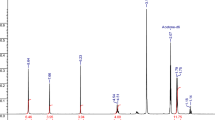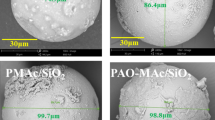Abstract
A bi-functional chelating sorbent is synthesised by introducing two different functionalities (amine and amidoxime groups) subsequently on the surface of an earlier synthesized cross-linked poly-acrylonitrile beads. The cross-linked base polymer beads are normally synthesised through suspension polymerisation using acrylonitrile and styrene as monomers and divinyl benzene as cross-linking agent. The bi-functionality is introduced by amination of base polymer in the first step by reacting with diethylenetriamine followed by amidoximation reaction with hydroxylamine hydrochloride in the second step. The incorporation of functional groups on beads are identified and confirmed with FTIR spectroscopy while the surface morphology, porosity and pores dimensions are evaluated by SEM and BET techniques. The saturation sorption capacity of synthesized beads for uranyl ion is tested and found ~ 45 mg g−1, which is significantly higher than the beads functionalized with sole amidoxime group. These bi-functional beads are quite efficient over a wide pH (1–10) range. The kinetics measurements indicate that the synthesized sorbents reach its saturation sorption capacity within 2 h at ~25 °C under neutral pH. In this study, the sorbed uranyl ions are eluted out with 1 M HCl efficiently. These beads exhibit excellent reusability up to three cycles without losing much of its capacity, suggesting better usability in real samples.











Similar content being viewed by others
References
Seko N, Katakai A, Tamada M, Sugo T, Yoshii F (2004) Fine fibrous amidoxime adsorbent synthesized by grafting and uranium adsorption-elution cyclic test with seawater. Sep Sci Technol 39:3753–3767
Benedict B, Pigford TH, Lewi HW (1981) Nuclear Chemical Engineering. McGraw-Hill
Gadd GM (2000) Bioremedial potential of microbial mechanisms of metal mobilization and immobilization. Curr Opin Biotechnol 11:271–279
Egawa H, Kabay N, Shuto T, Jyo A (2003) Recovery of uranium from seawater. XII. Preparation and characterization of lightly crosslinked highly porous chelating resins containing amidoxime groups. J Appl Polym Sci 46:129–142
Kabay N, Egawa H (1994) Chelating polymers for recovery of uranium from seawater. Sep Sci Technol 29:135–150
Chmielewski AG, Urbański TS, Migdał W (1997) Separation technologies for metals recovery from industrial wastes. Hydrometallurgy 45:333–344
Ritcey GM (1980) Crud in solvent extraction processing — a review of causes and treatment. Hydrometallurgy 5:97–107
Hudson MJ (1982) An introduction to some aspects of solvent extraction chemistry in hydrometallurgy. Hydrometallurgy 9:149–168
Hoh Y-C, Chuang W-Y, Wang W-K (1986) Interfacial tension studies on the extraction of lanthanum by D2EHPA. Hydrometallurgy 15:381–390
Tripathi SC, Bindu P, Ramanujam A (2001) Studies on the identification of harmful radiolytic products of 30% TBP-n-dodecane-HNO3 by gas liquid chromatography. i. formation of diluent degradation products and their role in Pu retention behavior. Sep Sci Technol 36:1463–1478
Bae SY, Southard GL, Murray GM (1999) Molecularly imprinted ion exchange resin for purification, preconcentration and determination of UO22+by spectrophotometry and plasma spectrometry. Anal Chim Acta 397:173–181
Seyhan S, Merdivan M, Demirel N (2008) Use of o-phenylene dioxydiacetic acid impregnated in Amberlite XAD resin for separation and preconcentration of uranium(VI) and thorium(IV). J Hazard Mater 152:79–84
Sadeghi S, Sheikhzadeh E (2009) Solid phase extraction using silica gel modified with murexide for preconcentration of uranium (VI) ions from water samples. J Hazard Mater 163:861–868
Northcott SE, Leyden DE (1981) Separation of uranium from molybdenum using a diamine functional group bonded to controlled-pore glass. Anal Chim Acta 126:117–124
Girgin S, Acarkan N, Sirkeci AA (2002) The uranium(VI) extraction mechanism of D2EHPA-TOPO from a wet process phosphoric acid. J Radioanal Nucl Chem 251:263–271
Singh Krishan K, Pathak Sanjay K, Kumar M, Mahtele AK, Tripathi SC, Bajaj Parma N (2013) Study of uranium sorption using D2EHPA-impregnated polymeric beads. J Appl Polym Sci 130:3355–3364
Singh K, Shah C, Dwivedi C, Kumar M, Bajaj Parma N (2012) Study of uranium adsorption using amidoximated polyacrylonitrile-encapsulated macroporous beads. J Appl Polym Sci 127:410–419
Toker Y, Eral M, Hicsonmez U (1998) Recovery of uranium from aqueous solutions by trioctylamine impregnated polyurethane foam. Analyst 123:51–53
Huang G, Li W, Liu Q, Liu J, Zhang H, Li R, Li Z, Jing X, Wang J (2018) Efficient removal of uranium (VI) from simulated seawater with hyperbranched polyethylenimine (HPEI)-functionalized polyacrylonitrile fibers, New. J Chem 42:168–176
Sebesta F, John J, Motl A (1997) Development of composite ion exchangers and their use in treatment of liquid radioactive wastes. International Atomic Energy Agency (IAEA) pp 79–103
Omichi H, Katakai A, Sugo T, Okamoto J (1986) A new type of amidoxime-group-containing adsorbent for the recovery of uranium from seawater. II. Effect of grafting of hydrophilic monomers. Sep Sci Technol 21:299–313
Kabay N, Katakai A, Sugo T, Egawa H (2003) Preparation of fibrous adsorbents containing amidoxime groups by radiation-induced grafting and application to uranium recovery from sea water. J Appl Polym Sci 49:599–607
Prasad TL, Saxena AK, Tewari PK, Sathiyamoorthy D (2009) An engineering scale study on radiation grafting of polymeric adsorbents for recovery of heavy metal ions from seawater. Nucl Eng Technol 41:1101–1108
Şahiner N, Pekel N, Güven O (1999) Radiation synthesis, characterization and amidoximation of N-vinyl-2-pyrrolidone/acrylonitrile interpenetrating polymer networks. React Funct Polym 39:139–146
Arica MY, Bayramoglu G (2016) Polyaniline coated magnetic carboxymethylcellulose beads for selective removal of uranium ions from aqueous solution. J Radioanal Nucl Chem 310:711–724
Bayramoglu G, Arica MY (2016) MCM-41 silica particles grafted with polyacrylonitrile: Modification in to amidoxime and carboxyl groups for enhanced uranium removal from aqueous medium. Microporous Mesoporous Mater 226:117–124
Bayramoglu G, Yakup Arica M (2016) Amidoxime functionalized Trametes trogii pellets for removal of uranium(VI) from aqueous medium. J Radioanal Nucl Chem 307:373–384
Bayramoglu G, Akbulut A, Arica MY (2015) Study of polyethyleneimine- and amidoxime-functionalized hybrid biomass of Spirulina (Arthrospira) platensis for adsorption of uranium (VI) ion. Environ Sci Pollut Res 22:17998–18010
Bayramoglu G, Akbulut A, Acıkgoz-Erkaya I, Arica MY (2018) Uranium sorption by native and nitrilotriacetate-modified Bangia atropurpurea biomass: kinetics and thermodynamics. J Appl Phycol 30:649–661
Chi F, Zhang S, Wen J, Xiong J, Hu S (2018) Highly efficient recovery of uranium from seawater using an electrochemical approach. Ind Eng Chem Res 57:8078–8084
Alexandratos SD, Zhu X, Florent M, Sellin R (2016) Polymer-supported bifunctional amidoximes for the sorption of uranium from seawater. Ind Eng Chem Res 55:4208–4216
Abney CW, Mayes RT, Saito T, Dai S (2017) Materials for the recovery of uranium from seawater. Chem Rev 117:13935–14013
Kanjilal A, Singh KK, Bairwa KK, Kumar M (2019) Synthesis and study of optimization of amidoximated PAN-DVB-EGDMA beads for the sorption of uranium from aqueous media. Polym Eng Sci 59:863–872
Bahramifar N, Yamini Y (2005) On-line preconcentration of some rare earth elements in water samples using C18-cartridge modified with l-(2-pyridylazo) 2-naphtol (PAN) prior to simultaneous determination by inductively coupled plasma optical emission spectrometry (ICP–OES). Anal Chim Acta 540:325–332
Scott RH, Strasheim A, Kokot ML (1976) The determination of uranium in rocks by inductively coupled plasma-optical emission spectrometry. Anal Chim Acta 82:67–77
Santos JS, Teixeira LSG, dos Santos WNL, Lemos VA, Godoy JM, Ferreira SLC (2010) Uranium determination using atomic spectrometric techniques: An overview. Anal Chim Acta 674:143–156
Shao D, Hou G, Chi F, Lu X, Ren X (2021) Transformation details of poly(acrylonitrile) to poly(amidoxime) during the amidoximation process. RSC Adv 11:1909–1915
Brandani S (2021) Kinetics of liquid phase batch adsorption experiments. Adsorption 27:353–368
Hubbe MA, Azizian S, Douven S (2019) Implications of apparent pseudo-second-order adsorption kinetics onto cellulosic materials: A review. BioResources 14:7582–7626
Hubbe MA (2021) Insisting upon meaningful results from adsorption experiments. Sep Purif Rev. https://doi.org/10.1080/15422119.2021.1888299
Tran HN, You SJ, Hosseini-Bandegharaei A, Chao HP (2017) Mistakes and inconsistencies regarding adsorption of contaminants from aqueous solutions: A critical review. Water Res 120:88–116
Ho Y, McKay G (1998) A comparison of chemisorption kinetic models applied to pollutant removal on various sorbents, Process Saf. Environ Prot 76:332–340
Yang X, Al-Duri B (2005) Kinetic modeling of liquid-phase adsorption of reactive dyes on activated carbon. J Colloid Interface Sci 287:25–34
Boyd GE, Adamson AW, Myers LS (1947) The exchange adsorption of ions from aqueous solutions by organic zeolites. II. Kinetics1. J Am Chem Soc 69:2836–2848
Langmuir I (1918) The adsorption of gases on plane surfaces of glass, mica and platinum. J Am Chem Soc 40:1361–1403
Freundlich HMFZ (1906) Over the adsorption in solution. J Phys Chem 57:385–471
Allen SJ, Gan Q, Matthews R, Johnson PA (2003) Comparison of optimised isotherm models for basic dye adsorption by kudzu. Bioresour Technol 88:143–152
Vukovic S, Watson LA, Kang SO, Custelcean R, Hay BP (2012) How amidoximate binds the uranyl cation. Inorg Chem 51:3855–3859
Mehio N, Lashely MA, Nugent JW, Tucker L, Correia B, Do-Thanh C-L, Dai S, Hancock RD, Bryantsev VS (2015) Acidity of the amidoxime functional group in aqueous solution: A combined experimental and computational study. J Phys Chem B 119:3567–3576
Greenwood NNEA (1997) Chemistry of the Elements, Second, Butterworth-Heineman, Oxford
Piron E, Domard A (1998) Interaction between chitosan and uranyl ions. Part 2. Mechanism of interaction, Int J Biol Macromol 22:33–40
Tang N, Liang J, Niu C, Wang H, Luo Y, Xing W, Ye S, Liang C, Guo H, Guo J, Zhang Y, Zeng G (2020) Amidoxime-based materials for uranium recovery and removal. J Mater Chem A 8:7588–7625
Humelnicu D, Dinu MV, Drăgan ES (2011) Adsorption characteristics of UO22+ and Th4+ ions from simulated radioactive solutions onto chitosan/clinoptilolite sorbents. J Hazard Mater 185:447–455
Ramachandhran V, Kumar SC, Sudarsanan M (2001) Preparation, characterization, and performance evaluation of styrene-acrylonitrile-amidoxime sorbent for uranium recovery from dilute solutions. J Macromol Sci A 38:1151–1166
Pal S, Ramachandhran V, Prabhakar S, Tewari PK, Sudersanan M (2006) Polyhydroxamic acid sorbents for uranium recovery. J Macromol Sci A 43:735–747
Chauhan GS, Kumar A (2008) A study in the uranyl ions uptake on acrylic acid and acrylamide copolymeric hydrogels. J Appl Polym Sci 110:3795–3803
Zhang H, Liang H, Chen Q, Shen X (2013) Synthesis of a new ionic imprinted polymer for the extraction of uranium from seawater. J Radioanal Nucl Chem 298:1705–1712
Acknowledgements
This research was carried out under the plan project no: RBA4013. Authors thank the Department of Atomic Energy, Government of India and Bhabha Atomic Research Centre for funding and all the members of Radiation and Photochemistry Division for their support.
Author information
Authors and Affiliations
Corresponding author
Ethics declarations
Conflict of interest
No conflict.
Additional information
Publisher's Note
Springer Nature remains neutral with regard to jurisdictional claims in published maps and institutional affiliations.
Rights and permissions
About this article
Cite this article
Kanjilal, A., Singh, K.K., Tyagi, A.K. et al. Synthesis of bi-functional chelating sorbent for recovery of uranium from aqueous solution: sorption, kinetics and reusability studies. J Polym Res 28, 460 (2021). https://doi.org/10.1007/s10965-021-02819-0
Received:
Accepted:
Published:
DOI: https://doi.org/10.1007/s10965-021-02819-0




